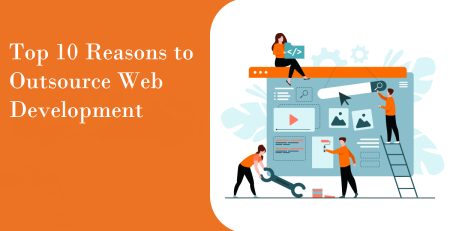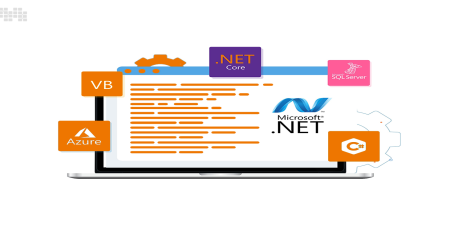Software Development Outsourcing Services
You’ve probably heard of software development outsourcing if you live in the twenty-first century. Despite disagreements about how and when to outsource software development and whether the effort is worthwhile, the IT offshoring market was worth $66.52 billion in 2019. So, is outsourcing something that isn’t worth your time, or is it a huge opportunity that you’re missing out on?
Nile Bits is a global software development firm that creates, builds, and delivers world-class standard products for Fortune 150 companies and promising startups.
In this article, we’ve summarized everything we know about outsourcing software development, including the benefits and drawbacks, as well as how to outsource software development correctly.
What is software development outsourcing?
In its most basic form, outsourcing is the practice of delegating certain tasks to an external vendor rather than using in-house resources. Outsourcing is now commonplace in almost every industry. According to Statista, the most commonly outsourced IT function in the tech industry is software application development.
Why should your startup outsource software development?
Outsourcing is faster and less expensive than in-house development because it eliminates the need for renting office space, establishing an entire development infrastructure, and assembling a professional team. But what are the other reasons for startups and established businesses to outsource software development?
Access to deep knowledge and experience
It is no secret that software engineering outsourcing is a great way to compensate for a lack of internal resources, allowing you to focus on your core tasks. However, this is only the tip of the iceberg. In fact, all you need to do is come up with a product idea, and you’ll have immediate access to a full suite of consulting, analytical, marketing, design, and development services.
Depending on your product type, project specifics, and budget, you can proceed to development or you can start by creating a minimum viable product (MVP) to validate your idea and make initial changes as necessary. In this case, the marketing and design experts of the outsourcing company will help you design the most optimal MVP and then interpret the analytical data it yields.
Outsourcing companies can do it all: project planning, cost estimation, wireframing, software development, and UI/UX design. And they do everything all the time. As a result, they can create the best project plan for any project.
Access to superior tech talents worldwide
When you decide to outsource your product development, such as a PLM software development project or a web design project, you are not restricted by geography. Your primary criterion should be the team’s skills and professionalism, not their proximity to your worksite.
Browse the company’s portfolio, look up customers’ feedback, check the reviews, try the products that the company has delivered, and you will be able to find the team that is perfect for your project’s needs. No matter where they are located, whether they work together or remotely, this deep pool of development talent will maximize the creation of your product.
When considering collaborating with a team that is half a world away or spread across multiple countries, we recommend taking cultural differences into account and taking steps to minimize their impact on the project development process.
Optimal balance of skills and rates
You can achieve the ideal balance between the team’s development skills and its rates by outsourcing. Your outsourcing options are geographically diverse, with India and Eastern Europe and Egypt among the most well-known software development outsourcing hubs.
Egypt is quickly rising in the outsourcing rankings. Software development companies operating in Egypt have demonstrated that they provide quality service with the optimal balance of expertise and creativity.
Furthermore, Egypt’s development rates are significantly lower than those in the United States or Western Europe. Outsourcing to Egypt will provide you with a high-quality, professionally delivered product at a significantly lower cost.
Ability to gather the best professional team for the project
If you start your project by assembling your own startup development team, you will most likely be significantly behind schedule.
Remember, for a successful product launch, you need not just developers to write the code and DevOps to deploy the product. To ensure a smooth product release, you also need business analysts, UI/UX designers, QA engineers, and copywriters. Additionally, your project may require highly specialized skills, such as virtual reality or AI. Finding such a broad range of experts may take quite some time. The time that could otherwise be spent doing the actual work on your project.
Usually, software development outsourcing companies already have a complete team on board, or they can quickly recruit known and trusted freelancers to fill positions if they need additional expertise. At the early project planning stage, the project manager is able to propose a team capable of delivering your project and identify the approximate time required from each team member.
No need for micromanagement
When you outsource your project to an outsourcing company, the project is coordinated by a project manager, whose job it is to manage outsourced software development. The project manager oversees all aspects of your product development and launch and serves as your primary point of contact for any issues that may arise.
You will meet the project manager at the very beginning of its development and will collaborate with them on its plan. Once you have approved the project plan and estimate, it is the project manager’s responsibility to adhere to the agreed-upon schedule and budget. Typically, the PM has tried and tested methodologies for managing both remote and in-house teams.
The PM will be responsible for planning sprints, setting deadlines, controlling delivery, scheduling, and preparing feature demos. Changes, suggestions, comments, and complaints can all be addressed to the project manager, and you can be confident that the necessary actions will be taken.
Effective communication within the team
It goes without saying that effective communication is critical. Fortunately, an outsourcing firm already has the tools and platforms in place for effective communication and collaboration. Preparing a collaboration environment for your project will take very little time and effort — a workspace in Slack, a project on GitHub, a board in Jira or Trello, and you’re pretty much done.
When a team is accustomed to working together, all issues, big or small, are resolved in the shortest and most effective manner.
Furthermore, because the primary and secondary skills of the team members are well known, the project manager will have little difficulty finding replacements in the event of illness or another emergency in a well-established team.
Application of the Agile methodology
For a startup, adhering to the principle of lean development is often critical. Doing so allows delivering a product with minimal unnecessary expenses or tasks resulting from incorrect management, poor communication, excessive complexity, or other issues related to the project coordination.
The Agile methodology favors the lean approach. In the most common model, the product creation process is broken down into sprints that are usually two weeks long. Each sprint has a goal (the product increment), which is typically a feature or functional component. After the product increment is developed, it is then tested and demonstrated at the end of the sprint.
Agile allows for revision on the go and adapting the development process to changed requirements. Over the lifecycle of a project, this reduces the need to redo finished components to a minimum.
Easy scalability
During project development, the scope of the project may expand or contract, requiring changes to be implemented. If this occurs, the initial team should be scaled up or down. That is difficult to achieve with in-house development.
And anyone who has built an in-house team knows that it is not easy to quickly find another team member with the required skills, especially if those skills are needed only for a single project. If you need to reduce the team, you will either have to dismiss people and risk being unable to replace their skill set in the future or continue paying their salaries to keep them onboard for future projects.
With software development outsourcing, you can avoid these problems because the agency usually has sufficient staff to cover your project needs. And when unique skills are required, they can contract a trusted freelancer or part-time team member on an hourly basis as needed. Similarly, reducing the team is no problem for an outsourcing agency since they may be running more than one project at the same time and can transfer the colleague to another assignment.
The practice of startup outsourcing has been around for quite a while, with a list of successfully outsourced projects easily in the hundreds, if not thousands, and the geographic scope covering the entire planet. Opera, Slack, and MySQL are great examples of successful outsourcing. Do you want to join the satisfied and successful crowd?
Cons of software development outsourcing
Outsourcing, of course, is not a cure-all. When you assign a project to a new team, you take a risk. Even with positive first contacts and positive reviews, there is still the possibility of miscommunications, delays, features developed differently than expected, and other challenges.
Outsourcing critics point to a lack of transparency. Information about quality control and labour conditions is frequently missing from your efforts to gain insights into the company’s processes and activities when outsourcing or offshoring.
So, how do you outsource the development of software to a third-party vendor with minimum risk? Start by contracting an agency for a small task. Make a detailed agreement specifying the quality, deadlines, rates, acceptance criteria. If you are satisfied with their performance, go ahead and sign a contract for a larger chunk of functionality or even for the complete project.
On the other hand, if you see that the agency is not up to the task, you can cancel the agreement at any time (just check the contract carefully, so you don’t run into legal troubles).
Under some contracts, you can terminate the agreement and still keep the developed project components. That allows you to start looking for a new software development outsourcing company to pick up where the first left off.
Software development outsourcing models
The process of outsourcing software development entails more than just paying a third-party vendor to code something for you. Actually, the development process starts with the selection of an outsourcing model.
We’ll go over three major options here: time and material (T&M), fixed price (FT), and dedicated team. Let’s take a closer look at each one.
Time and material
Using T&M, the client pays for the time spent exclusively on the development. This model is best suited for small or medium projects without predetermined requirements. It is also ideal for projects that require only limited resources (1-3 resources).
Pros
- Flexibility. Since the initial specifications are unsettled, the client can quickly change the work plan if circumstances require. As a result, T&M combines ideally with various agile methodologies.
- Client engagement. Due to the adoption of agile methodologies, the client can see all stages of development. This increases the likelihood that the end result will align with the client’s expectations.
Cons
- Budget. Undefined requirements make budget estimations challenging.
- Slow time-to-market. T&M involves lots of communication throughout the project, which slows down the process.
Fixed-price
The fixed-priced model assumes that both parties agree in advance on the specifications, project scope, and of course, the price, hence the name. Since modifications are not an option, this model works best for small projects. FP is a perfect solution when you are testing the waters with a new software development vendor.
Pros
- Specifications. You will get what you need, within budget.
- Time-to-market. Since the time frames are agreed upon in advance, the project is more likely to be delivered on time.
Cons
- Risks. The FP model doesn’t leave room for any changes, making risk management extremely difficult.
Dedicated team
With the dedicated team model, throughout the project, the client pays a fixed monthly salary to the hired specialists in addition to administrative costs. This collaboration type is well-suited for long-term projects with vague requirements and large in-house projects when the client’s staff lacks specific expertise.
Pros
- Control. The client has full control over their dedicated team and the workload.
- No onboarding hustle. Since the vendor handles all the hiring and administrative tasks, you can focus all of your attention on the business aspects of a project.
Cons
- Unclear requirements. The lack of well-formed specifications gives a remote team room for creativity, which can result in discrepancies between the client’s expectations and the end result. You can leverage those experiments with a top-rated software development vendor.
For ease of reference, Nile Bits dedicated software development team have summarized the key aspects of each model in the table below:
| Characteristics | T&M | Fixed-price | Dedicated team |
| Project size | Medium, small | Small | Large |
| Price type | An hourly wage | A fixed price for the entire project | Fixed salaries for individual resources |
| Resources | Unclear | Clearly defined | Estimated |
| Scope | Unclear | Clearly defined | Estimated |
| Requirements | Unclear | Clearly defined | Estimated |
As you can see, there are no right or wrong models. Your choice will depend on your business type and project requirements.
How to set up your outsourcing strategy?
Increasing productivity, improving product quality, and lowering costs are just a few of the advantages of outsourcing software development. You won’t be able to successfully outsource IT development unless you plan ahead of time, so having a solid outsourcing strategy is the first step toward hiring a vendor to meet your needs. But how do you make one? Here are a few things to think about.
Define your goals
Cost reduction is a common reason for outsourcing, but it is not the only good reason — don’t limit your search to vendors based solely on price. Other advantages of outsourcing include capitalizing on advanced technologies, streamlining processes, and lowering the risk of business expansion. Your objectives should be realistic, well-balanced, and attainable.
Define tasks for delegation
While some companies are known for their coding prowess, others are well-known for their consulting services. To find the best outsourcing match, you must first define which tasks you want to outsource.
Tip: Delegate tasks that are less important to you at the start of your outsourcing journey.
Determine your technological profile
Because software development outsourcing is typically done remotely, it’s critical that your vendor has a technological profile that matches your requirements. To that end, we recommend making a list of the resources needed for your project. Also, don’t overlook security and data protection features, as data leakage is common.
Establish a good job climate
Foster good relationships between your staff and outsourced employees: inform them of the outsourcing goals, avoid rumors, and close any cultural gap between your team and your vendor’s team. Make sure your company is actually ready for changes.
How is software development usually done?
Whatever the complexity of a software product, it must be flexible, easy to maintain, and upgradeable. This can be accomplished by pre-planning each step, from brainstorming to maintenance. The phases of the software development life cycle (SDLC) vary by vendor. They are: Relevant
- Ideation
- Planning
- Design
- Coding
- Testing
- Deployment and maintenance
Let’s examine each one more closely.
Ideation
Every project starts with an idea. However, ideas don’t come out of nowhere. First, you must identify a business need and then consider ways to bring it to life. In most cases, the project initiation phase includes the following:
- Conducting a feasibility study to evaluate the likelihood of successful project completion and to minimize possible risks
- Determining the project’s scope
- Identifying deliverables (the project’s expected results)
- Identifying stakeholders
- Developing a business case that provides the justification for undertaking the project
- Developing a statement of work that specifies the project’s objective(s), scope, and deliverables
Planning
The planning phase typically includes the following components:
- creating a project plan
- building your team
- identifying the role of each team member
- estimating the budget
- making sure everyone has the necessary resources (both hardware and software)
- anticipating risks.
Making sure that the necessary development tools, platforms, and communication channels are all available and accessible is a critical component. Essentially, you want to ensure flawless daily processing while not depleting resources or interfering with ongoing development.
Another pillar of your success will be well-organized documentation. Documentation consistency at all stages is critical for maintaining proper communication, work processes, reporting, and facilitating interaction among team members.
It is strongly advised that you use a software requirements specification (SRS) to summaries everything done during the planning stage. An SRS is a document that specifies what a product should do and how it should be developed.
Design
Design is a crucial component of the software project’s lifecycle. It may include the following:
- Architecture — the overall design of the product
- User interface — the way users will interact with the product and how it will respond
- The definition of platforms on which the product will run (Android, iOS, etc.)
- Communications — ways the product will communicate with other assets (the central server, for example)
- Security — measures to protect the app from data leakages, such as SSL encryption, password protection, and the like
The design phase may also involve creating a prototype, the visual representation of how the project looks and works.
Coding
As the backbone of the SDLC, this stage is all about ‘translating’ the product’s design into the actual software.
While a small project can be completed by a single developer, for large projects, all tasks are divided among team members based on their areas of expertise. Thus, a front-end developer builds the product’s UI and its communication with the server; database administrators add all the necessary data to the database.
It’s vitally important to make sure that the code meets the project’s requirements and lives up to the stakeholder’s expectations. No wonder that this stage is the longest. Yet, if the ideation and planning were carefully completed, it’s also the easiest one.
The goal of this phase is to build a working product and a source code document.
Testing
As soon as the development phase is completed, it’s time for QA experts to check if it meets all the requirements. For this purpose, the software undergoes several types of testing:
- Functional testing, to verify that the software performs its stated functions in a way users expect
- Performance testing, to see how the software performs under a heavy workload
- Unit testing, to make sure that each module performs as expected
- Security testing, to ensure that the software is free from risks and threats that can cause data leakage
- Usability testing, to find out if the software is intuitive and responsive
Once an identified error is fixed, developers then forward the software back to the QA team for re-testing. This process repeats until the entire product is bug-free.
Deployment and maintenance
When the testing phase is completed successfully and there are no discernible bugs or other flaws in the product, it is released to the market for beta testing. The support team collects user feedback during beta testing, and if any problems arise, the development team resolves them.
Only after the product has been fine-tuned in response to real-world feedback is it released to the public. The product’s life cycle does not end there; instead, it is regularly updated to improve performance and meet the ever-changing needs of its users.
You might be interested in learning how to hire an iOS development team as well as an Android development team.
Where to outsource, and how much does it cost?
One of the primary reasons why people outsource is to save money. Taxes and the cost of office space differ from country to country. As a result, outsourcing software development to specific locations may cost you a fortune. For example, while the average software developer in the United States earns $77K per year, their Egyptian counterpart earns 10 times less.
However, the vendors with the lowest prices may not provide the best quality. Analyzing different countries based on the following criteria will assist you in determining the best balance:
- Tech education opportunities
- Positions in global ratings of IT destinations
- Time zone difference
- The level of English proficiency
- Resources availability and tech competency diversity
- Cultural mindset
Based on these criteria, Egypt is regarded as one of the best outsourcing destinations in the world, and the low hourly rates (ranging from $20 to $60) are not the only reason for this.
Local dedicated software development teams have consistently demonstrated their ability to produce a high-quality end product and provide services to meet all of their customers’ needs due to their extensive educational backgrounds and comprehensive skill sets, combined with mature management teams.
Furthermore, whether you need AI, robotics, or IoT, highly customized application development (e.g. equity management software development), predictive software development techniques, or modern mobile app development, you can find it here. Furthermore, R&D initiatives in Egypt tech and software engineering sectors are thriving. Companies such as IBM and Microsoft have taken notice, and they are already utilizing the local IT market’s improved technology and field-specific advancements for their research and development needs.
Of course, there are other places to visit. However, the benefits listed above make Egypt an appealing country for outsourcing. As a result, it’s no surprise that tech titans like Intel, eBay, Apple, and SolarWinds are leveraging its deep IT and software development expertise.
How to choose a software development vendor?
With 23 million developers worldwide, selecting the right software development outsourcing partner may appear impossible. In fact, the selection process is similar to that of any other service provider, with a few industry-specific variations.
Take the following steps to find your perfect fit:
- Identify what you need (an app type, platforms to run your app, tech stack, estimated deadlines, etc.).
- Search for candidates based on your identified needs.
- Choose several candidates, explore their websites, browse case studies, try to find their profiles somewhere other than their own sites (LinkedIn, Clutch), read their corporate blogs and Google customer reviews.
- Reach out to the candidates to learn about their rates, expertise, certifications, security measures, communication style, and the like. Sift your list in response to the information you receive.
- Reach out to clients of the shortlisted vendors and ask for references.
- Discuss your project with the selected candidates. Ask the potential prospects for estimates on time and budget.
- Finally, ask the remaining candidates to do a test. The task shouldn’t take more than two working days. Whatever the result, always pay for the test assignment.
The company that met all of the above evaluation criteria is likely to be a dependable outsourcing vendor. Please read our blog post for more information on each of the steps.
Software development outsourcing contract details
After you’ve found the ideal software development vendor, the next step is to sign the software development outsourcing contract.
A software development contract, like any other service agreement, includes general terms, termination conditions, dispute resolution, and so on. However, there are some specific sections to include for IT outsourcing:
- The services. This section should describe in detail the services and the project scope that you expect your outsourcing partner to deliver, as well as the process for making changes to the scope.
- Project time and cost. Here, you should specify hourly rates, development phases, milestones and their deadlines, responsibility for delays, payment schedules, and the like.
- Acceptance testing (AT) is a test conducted to determine whether contract requirements are met. This section states which party is responsible for the testing, how long it takes, and how the results are communicated.
- Intellectual property rights. The end product is the customer’s property; it does not belong to the developer. Make sure the contract clearly states that.
- Confidentiality. This section specifies which information is considered confidential, and the responsibility for, and ramifications of, its disclosure.
The contract formalizes your relationship with the software development vendor. Your partner can now begin writing code for your product.
Relevant as an outsourcing partner
Finding a trustworthy outsourcing partner can be a difficult task. But if you’re reading this on the official Nile Bits website, you don’t have to go through all those circles of hell — you’ve come to the right place.
Nile Bits is an offshore software development company that employs highly skilled Egyptian developers. Our mission is to assist existing businesses and startups in developing world-class software at a low cost. Since 2014, we have successfully provided the following services:
- Dedicated team
- Web and mobile development
- Quality assurance
- Digital design
- Cybersecurity
- DevOps
- AI/ML
- Salesforce development
Summary
Outsourcing is unquestionably a complicated issue. However, with the right service provider, careful contracting, and clear communication of your business needs, you will receive in-depth knowledge and the implementation of capital-saving techniques that will allow you to achieve the best results within time and budget.
Please let us know if you are looking for an outsourced development team. We have no doubt that your idea deserves to be successful as well. Please do not hesitate to contact us!













Leave a Reply